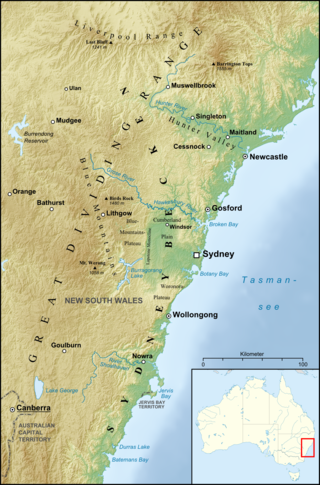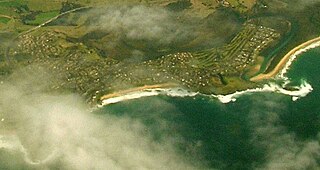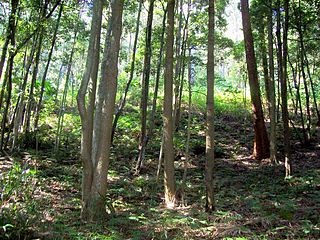
The Budderoo National Park is a 7,219-hectare (17,840-acre) national park that is located in the Illawarra region of New South Wales, Australia; situated approximately 99 kilometres (62 mi) south southwest of Sydney.

Mount Keira is a suburb and mountain in the Illawarra region of New South Wales, Australia.

The Sydney Basin is an interim Australian bioregion and is both a structural entity and a depositional area, now preserved on the east coast of New South Wales, Australia and with some of its eastern side now subsided beneath the Tasman Sea. The basin is named for the city of Sydney, on which it is centred.

The Illawarra escarpment, or officially the Illawarra Range, is the fold-created cliffs and plateau-eroded outcrop mountain range west of the Illawarra coastal plain south of Sydney, in the state of New South Wales, Australia. The range encloses the Illawarra region which stretches from Stanwell Park in the north to Kiama, Gerringong and the Shoalhaven River in the south.

Minnamurra is a village in the Illawarra region of New South Wales, Australia, in the Municipality of Kiama. It has a station on City Rail South Coast line. The Minnamurra River flows into the ocean at Minnamurra. There is a sandy beach and a sand spit at the river mouth.

The Cumberland Plain, also known as Cumberland Basin, is a relatively flat region lying to the west of Sydney CBD in New South Wales, Australia. An IBRA biogeographic region, Cumberland Basin is the preferred physiographic and geological term for the low-lying plain of the Permian-Triassic Sydney Basin found between Sydney and the Blue Mountains, and it is a structural sub-basin of the Sydney Basin.

The Wianamatta Group is a geological feature of the Sydney Basin, New South Wales, Australia that directly overlies the older Hawkesbury sandstone and generally comprise fine grained sedimentary rocks such as shales and laminites as well as less common sandstone units.

The Central Tablelands in New South Wales is a geographic area that lies between the Sydney Metropolitan Area and the Central Western Slopes and Plains. The Great Dividing Range passes in a north–south direction through the Central Tablelands and includes the Blue Mountains. The region shares borders with the Hunter, Central West Slopes and Plains, South West Slopes, Southern Tablelands, North Western Slopes and Plains, the Sydney Metropolitan Area and the Illawarra.

The Narrabeen group of sedimentary rocks occurs in the Sydney Basin in eastern Australia. This series of rocks was formed in the Triassic Period.

The Garawarra State Conservation Area is a protected conservation area that is located on the southern suburban fringe of Greater Sydney, in the state of New South Wales, in eastern Australia. The 949-hectare (2,350-acre) reserve abuts the Royal National Park and is situated 40 kilometres (25 mi) south of the Sydney central business district, near Helensburgh. Garawarra was gazetted as a park in 1987, and added, together with the Royal National Park, to the Australian National Heritage List on 15 September 2006.

Gerroa is a coastal town in the Municipality of Kiama, in the Illawarra region of New South Wales, Australia 133 kilometres south of Sydney. It is considered to be the southernmost town in the Illawarra region. Nearby towns are Gerringong, Kiama and Berry.

The Illawarra Coal Measures is a group of sedimentary rocks occurring in the Sydney Basin in eastern Australia. This stratum is up to 150 metres thick. Formed in the Late Permian, it comprises shale, quartz-lithic sandstone, conglomerate rocks, and chert, with sporadically carbonaceous mudstone, coal and seams of torbanite. Coal mining of these measures remains a significant commercial enterprise to the present day. One of the abandoned coal mines in the Blue Mountains is now a tourist attraction.

Bald Hill Claystone is a sedimentary rock found in the Sydney Basin in eastern Australia. It is part of the Clifton sub-group of the Narrabeen Group of sedimentary rocks. It was formed by weathering of the Gerringong Volcanics in the early Triassic. Named after Bald Hill, in the northern Illawarra, where it is 15 metres thick. The claystone is easily noticed at Long Reef, where it is 18 metres thick.

The Cambewarra Range Nature Reserve, as part of the Kangaroo Valley Group of Nature Reserves, is a protected area located on the cliffs and plateaus of the Kangaroo Valley in the Southern Highlands and South Coast regions of New South Wales in eastern Australia. The Reserve is situated approximately 150 kilometres (93 mi) south of Sydney, 50 kilometres (31 mi) southwest of Wollongong and 16 kilometres (9.9 mi) northwest of Nowra. The Reserve has a total area of 1684 hectares, and includes 11 privately owned properties. It is critical for it to be pristine for a variety of reasons, not the least the catchment of water, as the Reserve floor flows into the Kangaroo Valley River and the Shoalhaven River, from which the Sydney Water Authority draws water to supply large populations in Sydney and Wollongong.

Bulgo Sandstone is a sedimentary rock occurring in the Sydney Basin in eastern Australia. This stratum is up to 100 metres thick, formed in the early Triassic (Olenekian). A component of the Narrabeen Group of sedimentary rocks. It consists of layers of fine to medium-grained quartz-lithic sandstone, with lenticular shale interbeds.

The Coastal Upland Swamps are critically endangered swamp areas scattered in the Sydney area and the Illawarra Escarpment which feature flora and fauna associated with sporadically marshy soils on the Hawkesbury sandstone plateaus. It occurs in the eastern Sydney area from the Somersby district in the north to Robertson in the south.

The Illawarra-Shoalhaven subtropical rainforest, or Illawarra Subtropical Rainforest (ISR), is a scattered rainforest community in the Illawarra region of New South Wales, Australia. Occurring just south of Sydney, it spans from the Royal National Park (north of Wollongong) to the Milton-Ulladulla district in the south, albeit in scattered fragments.

The Caley Formation is a band of sedimentary rocks occurring in the Sydney Basin in eastern Australia. This stratum is up to 46 metres thick. The formation consists of claystone, shale and quartz-lithic sandstone. Often seen situated below the Burra-Moko Head Sandstone in the cliffs of the Blue Mountains.

Berry Siltstone is a sedimentary rock from the Shoalhaven Group, occurring in the Sydney Basin in eastern Australia. Heavy yellow clay soils form from this strata. Consisting mostly of siltstone, it may be seen in areas such as the Southern Highlands, Illawarra and at the base of the Grose Valley. Berry Siltstone was laid down on the ocean floor in the Permian around 260 million years ago, when this location was situated at the South Pole.


















